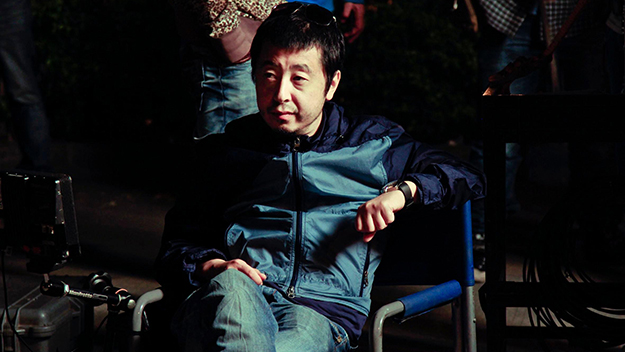News to Me: Jia Zhangke, Christian Petzold, and the moon landing

Jia Zhangke on the set of Ash Is Purest White (2018). Photo by Arte France Cinéma/Kobal/Shutterstock.
1. “Of all the fables that have grown up around the moon landing, my favorite is the one about Stanley Kubrick, because it demonstrates the use of a good counternarrative . . . It started with a simple question: Who, in 1969, would have been capable of staging a believable moon landing?” For the 50th Anniversary of our (supposed) moon landing, Rich Cohen writes for The Paris Review on the odysseys and oddities of Stanley Kubrick.
2. More moon landing content: in 1960s, in the midst of the Space Race, a Zambian freedom fighter hoped to beat the U.S. and USSR to the moon with an unofficial space program and a 17-year-old astronaut. Ghanaian filmmaker Nuotama Frances Bodomo tells an alternative, fictionalized history of these events with her expressionistic black-and-white short Afronauts (2014)—once a New Directors/New Films selection and now available online via vernac.media.
3. Jia Zhangke has officially finished shooting his forthcoming documentary So Close to My Land, a film focused entirely on three Chinese writers: Jia Pingwa, Yu Hua, and Liang Hong. The film chronicles “a spiritual history of the Chinese people” as seen through the eyes of the three writers, following Dong (2006) and Useless (2007) as the conclusion to Jia’s “art” trilogy.
4. The day after four Brazilian films were announced as selections for the 2019 Locarno International Film Festival, Jair Bolsanaro threatened closure of ANCINE, the Brazilian National Film Agency, unless they accept certain “filters.” Though it’s unclear exactly what those filters would entail, Bolsanaro has publicly requested more stories concerning “Brazilian heroes.” ANCINE is currently responsible for $300 million in funding per year for Brazil’s film and television industries.
5. Christian Petzold recently began shooting his new film, Undine, re-teaming with Transit stars Paula Beer (in the title role) and Franz Rogowski. Adapting the multifarious myth of a water nymph who, like a succubus or siren, seduces men for their souls, Petzold’s take on the character places Undine in modern-day Berlin as a history graduate seeking control of her own fate. (See also this recent Jonathan Rosenbaum piece wherein, having recently seen Transit, he apologizes for previously being mean to Petzold’s films: “Well, I guess one lives and learns.”)
6. “50 years ago, British soldiers arrived in Northern Ireland. We’ve tried to mark that arrival in an unusual way . . . Instead of talking directly about war, we’ve decided to look at movies.” Mark Cousins is teaming up with Channel 4 once again for a documentary studying The Troubles on Film (a working title). Cousins previously collaborated with Channel 4 on his 15-part documentary series, The Story of Film: An Odyssey (2011), which he wrote, directed, and presented.
7. If the recent Cats trailer gave you pause, consider this investigation into the uncanny valley from Filmmaker magazine’s Joanne McNeil: “What’s ‘right’ tends to be a seamless and effortless look, which means there is a paradox to the trade—all that work, at best, appears as if it never happened at all.” And if that gets you purring: check out this longform piece on the history and ever-evolving applications of CGI from e-flux Architecture.
8. Damien Chazelle has announced his next feature, Babylon, which will focus on the transition from silent films to “talkies” in 1920s Hollywood. Emma Stone, who won an Oscar for her performance in Chazelle’s La La Land (2016), is currently set to star, with Brad Pitt apparently circling the project. Jordan Raup at The Film Stage hypothesizes that the film’s title is likely “a nod to Kenneth Anger’s infamous book, Hollywood Babylon, which told of Tinseltown scandals throughout the first half of the 20th century.”
9. Le Cinéma Club continues its unexpected (but all too welcome) revival as a curator-cum-preservationist, this week showing a new restoration of Yasujiro Ozu’s 1929 short film A Straightforward Boy. Thanks to a recent discovery by the Kyoto Toy Film Museum, the film will screen with eight extra minutes of long-unseen footage, available until the end of the week. For more Ozu: check out this 2016 piece by Film Comment contributor and filmmaker Paul Schrader.
10. Over at Walden, Frida Sandström writes on the filmic careers of Chris Kraus and Yvonne Rainer: “What connects them is that they both have had careers as filmmakers, years that had a big influence on their main occupations. Since then, they both think through the frame of analogue video editing.” A few years back, Rainer spoke with Violet Lucca on The Film Comment Podcast about dance, film, and feminism.
We leave you this week with Peter Falk and Cassavetes dancing at a phone-a-thon thing:







